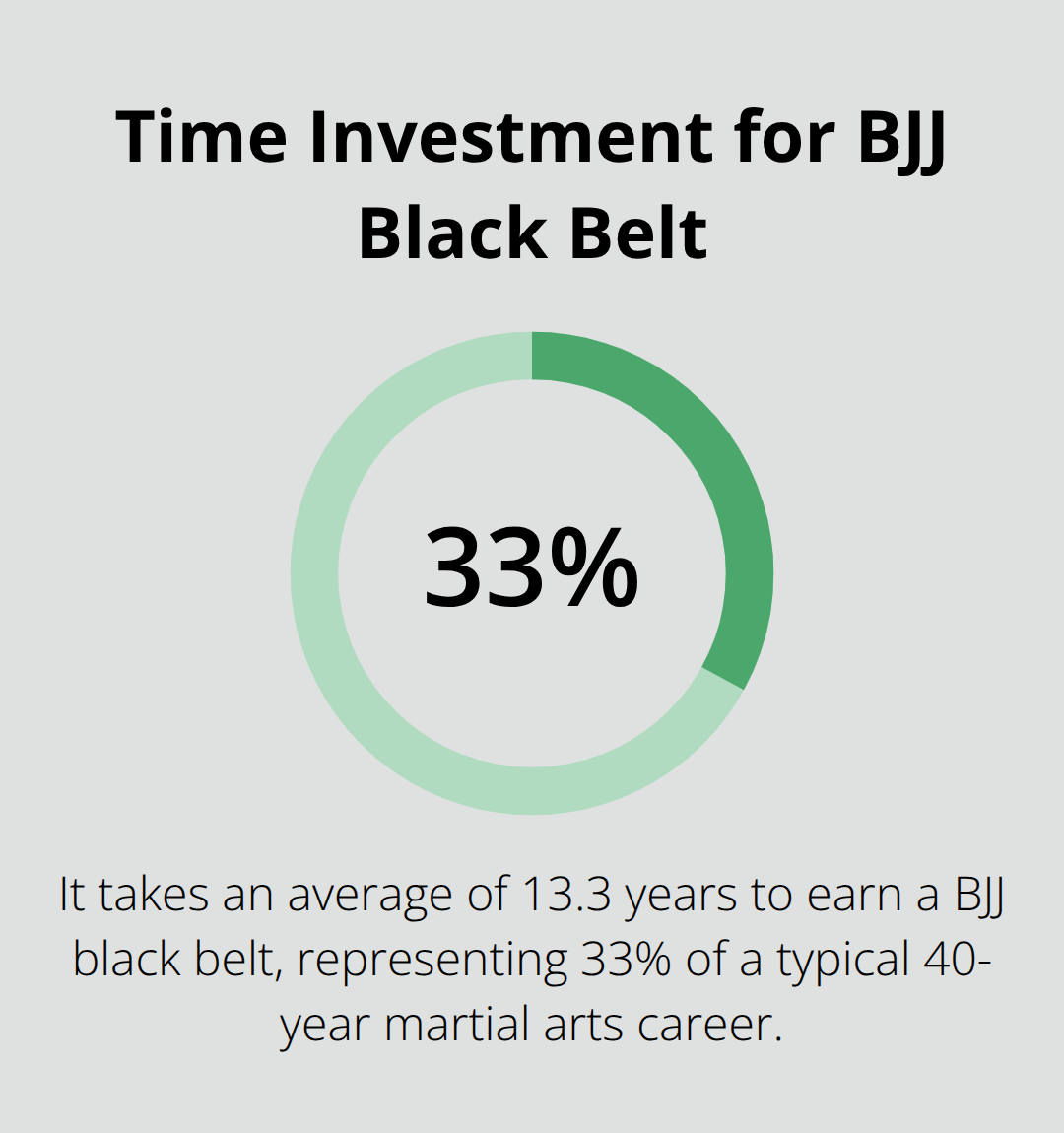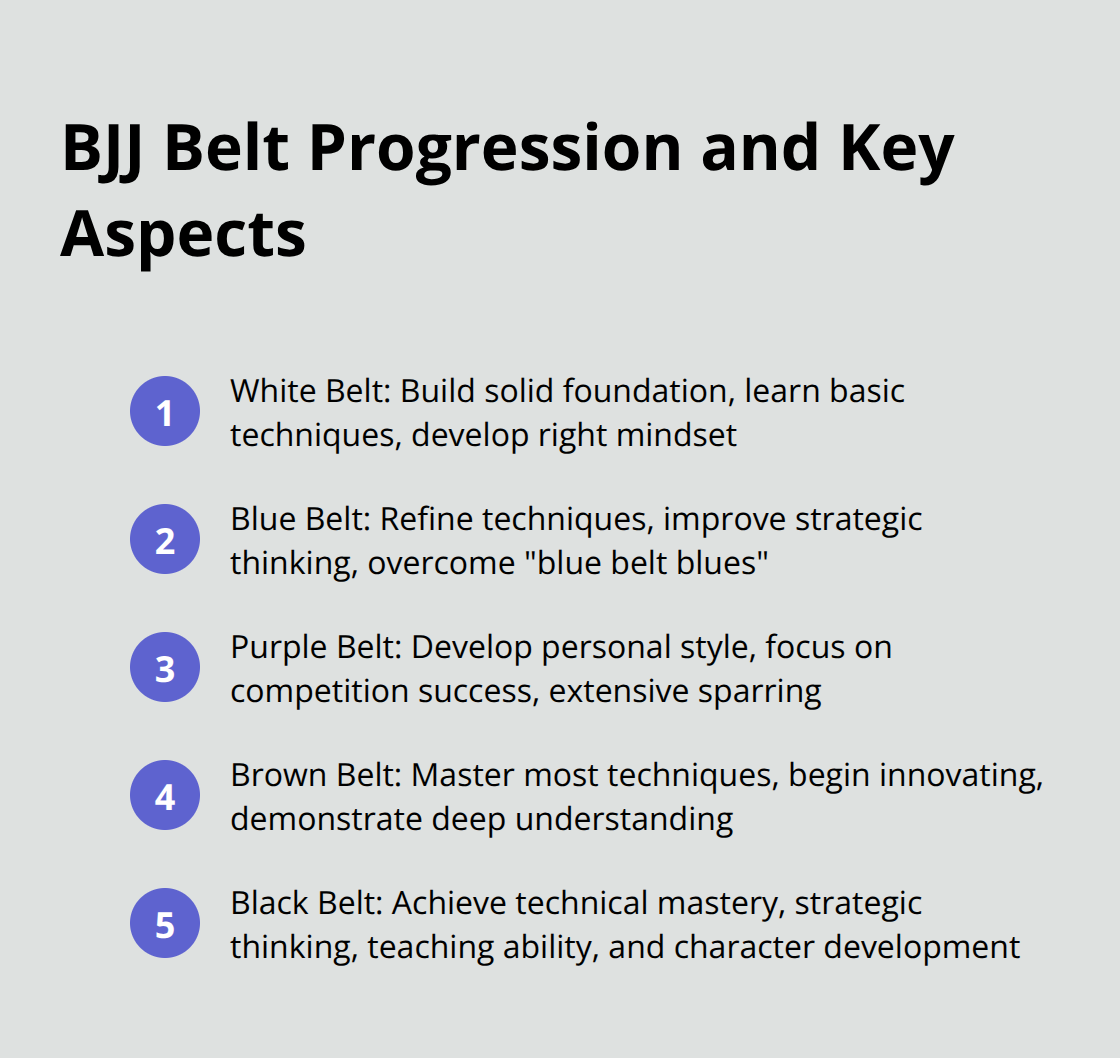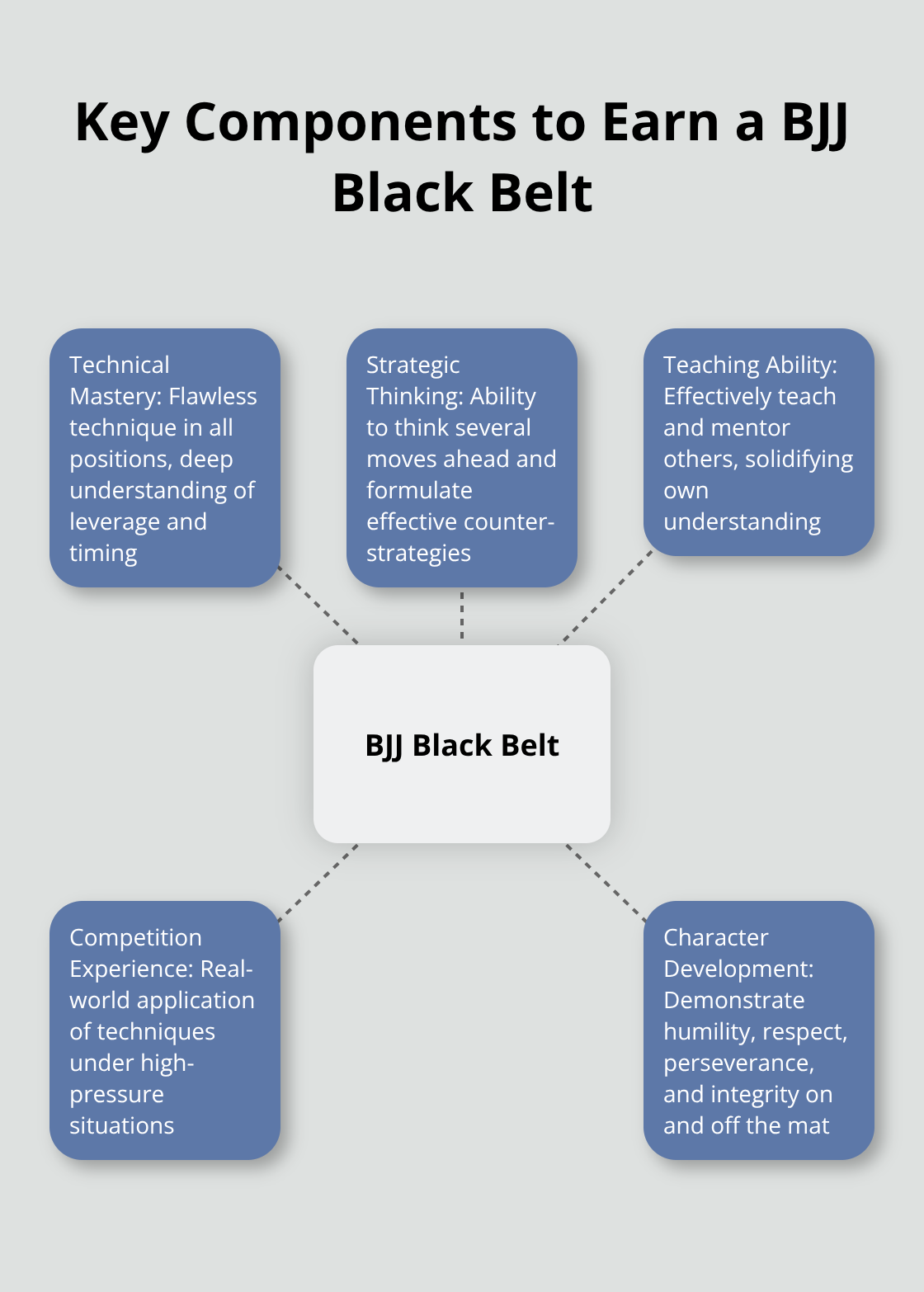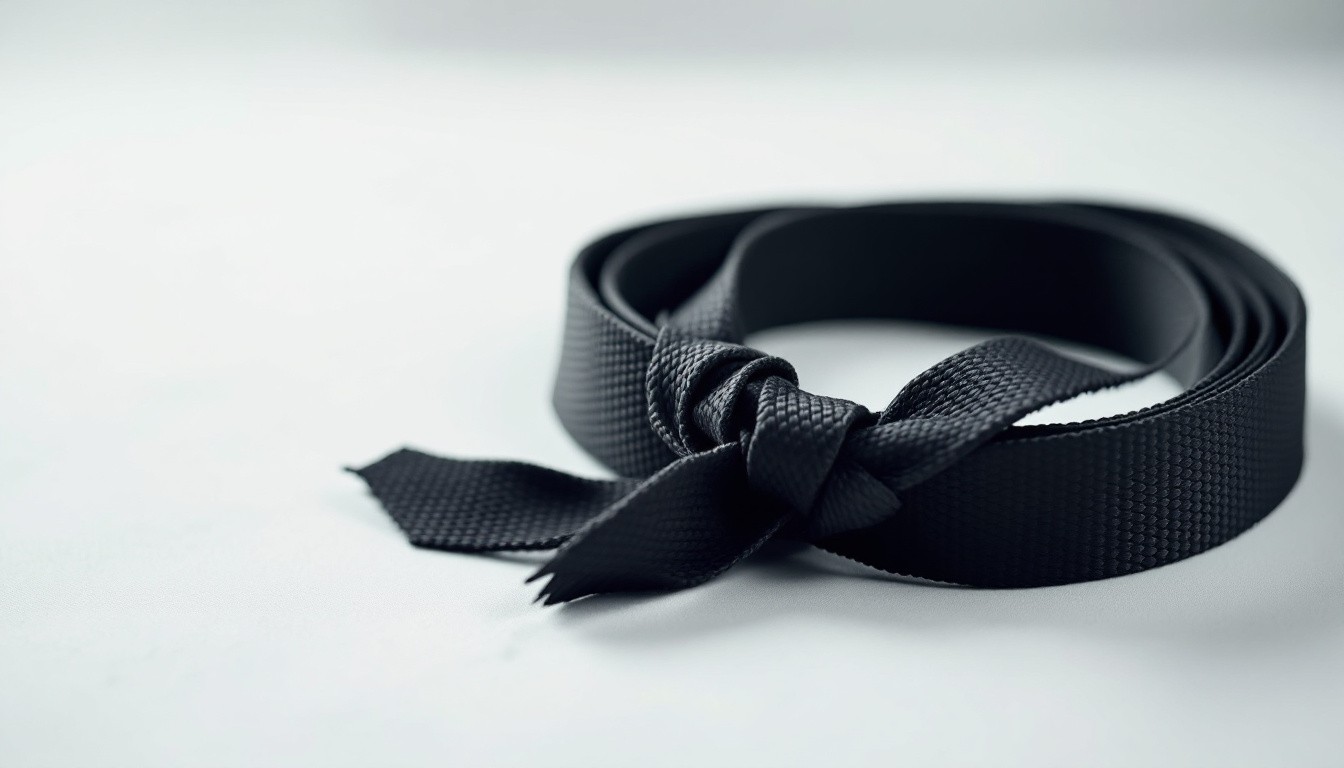At Jiu jitsu, we know that earning a black belt in Brazilian Jiu-Jitsu is a monumental achievement. It represents years of dedication, sweat, and personal growth.
The journey to a BJJ black belt is filled with challenges, triumphs, and invaluable lessons both on and off the mat.
In this post, we’ll explore what it truly means to attain this prestigious rank and provide insights on how to earn one.
What Does a BJJ Black Belt Represent?
The Pinnacle of Achievement
A Brazilian Jiu-Jitsu (BJJ) black belt represents the pinnacle of BJJ skill. At Souza Grappling Co., we witness how this rank transforms practitioners both on and off the mat. The black belt represents not just technical proficiency, but a deep commitment to BJJ’s philosophy and principles.
Origins of the Belt System
The BJJ belt system emerged in the early 20th century when the Gracie family adapted judo techniques to create a ground-focused martial art. They introduced the black belt as the highest rank, quickly establishing it as a symbol of exceptional skill and knowledge.
A Long-Term Commitment
Unlike some martial arts where practitioners can earn black belts in a few years, BJJ demands an extraordinary time investment. It takes an average of 13.3 years to earn a BJJ black belt. This extended journey ensures that only the most dedicated and skilled individuals achieve this rank.

Beyond Technical Mastery
A BJJ black belt signifies more than flawless technique execution. It represents:
- Deep strategic understanding
- Ability to innovate
- Capacity to teach and mentor others
Black belts often take on leadership roles within their academies and contribute to the growth of the art. At Souza Grappling Co., we emphasize that the path to a black belt shapes not just grappling skills, but character and life approach.
The Journey’s Impact
The road to a black belt transforms practitioners in numerous ways:
- Physical fitness and body awareness improve dramatically
- Mental toughness and resilience develop through challenges
- Problem-solving skills sharpen (both on and off the mat)
- A sense of community and camaraderie grows among training partners
As practitioners progress through the ranks (white, blue, purple, and brown), they face unique challenges and milestones. Each belt level brings new techniques, strategies, and personal growth opportunities. This journey doesn’t end at black belt; it marks the beginning of a new chapter in a lifelong pursuit of martial arts excellence.
The Path to BJJ Mastery
White Belt Foundations
Every BJJ journey starts at white belt. This initial stage builds a solid foundation of fundamental techniques and develops the right mindset. White belts typically spend 1-2 years learning basic positions, escapes, and submissions. It’s important to embrace discomfort and maintain consistency in training.
Blue Belt Progression
As practitioners advance to blue belt, they refine techniques and improve strategic thinking. Blue belts often experience the infamous “blue belt blues,” a period of doubt and frustration that tests their resolve. Overcoming this phase marks a significant milestone in a practitioner’s journey.
Purple Belt Development
Purple belts (often considered the middle ground of BJJ) start to develop their own style and focus on competition success. This phase involves extensive sparring and competition experience.
Brown Belt Mastery
The brown belt phase embodies the art of BJJ. Practitioners become proficient in most techniques and begin to innovate their own. This stage involves extensive sparring, competition experience, and often teaching lower belts. Brown belts must demonstrate not just technical proficiency, but also a deep understanding of BJJ principles and strategy.
Consistency and Dedication
Throughout this journey, consistent training remains non-negotiable. This level of dedication not only improves technical skills but also develops mental toughness and resilience.
Many BJJ schools (including Souza Grappling Co.) provide structured curricula and supportive environments to guide practitioners through each belt level. Experienced instructors offer personalized feedback and encouragement, helping students overcome plateaus and continue progressing. Goal-setting at each stage (whether it’s mastering a specific technique or competing at a higher level) plays a vital role in a practitioner’s development.

As practitioners progress through the ranks, they not only enhance their grappling skills but also develop character traits that extend far beyond the mat. The next section will explore the specific requirements and skills necessary to achieve the coveted black belt in Brazilian Jiu-Jitsu.
What It Takes to Earn a BJJ Black Belt
Earning a Brazilian Jiu-Jitsu black belt demands an extraordinary level of commitment, skill, and personal growth. This pinnacle of achievement requires 10 to 15 years of consistent, focused training on average. Let’s explore the key components necessary to reach this prestigious rank.

Technical Mastery Across All Positions
A BJJ black belt must demonstrate flawless technique in every position. This includes executing submissions, escapes, and transitions from guard, mount, side control, and back control. Black belts are expected to have a deep understanding of leverage, timing, and body mechanics.
To develop this level of proficiency:
- Drill techniques relentlessly (try to perform at least 1000 repetitions of core movements).
- Spar with partners of varying sizes and skill levels to adapt techniques to different body types.
- Attend seminars with world-class instructors to expand your technical repertoire.
Strategic Thinking and Problem-Solving
BJJ is often likened to human chess. Black belts must think several moves ahead, anticipate their opponent’s actions, and formulate effective counter-strategies. This level of strategic thinking develops through years of sparring and competition experience.
To sharpen your strategic abilities:
- Analyze your sparring sessions and matches. Identify patterns in your opponents’ behavior and develop counters.
- Study high-level competition footage, focusing on the decision-making process of elite athletes.
- Engage in specific training scenarios that force you to problem-solve under pressure.
Teaching and Mentorship
A key aspect of earning a black belt is the ability to effectively teach and mentor others. This not only solidifies your own understanding but also contributes to the growth of the BJJ community.
To develop your teaching skills:
- Volunteer to assist with beginner classes at your academy.
- Create detailed lesson plans for techniques you want to teach.
- Seek feedback from students and adjust your teaching methods accordingly.
Competition Experience
While not mandatory, competition experience significantly enhances a practitioner’s skill set. It provides real-world application of techniques under high-pressure situations.
To maximize your competition journey:
- Start competing early in your BJJ career (even as a white belt).
- Set realistic goals for each competition, focusing on performance rather than just results.
- Use competition experiences to identify weaknesses in your game and address them in training.
Character Development
Perhaps the most important aspect of earning a black belt is the development of character. BJJ instills humility, respect, perseverance, and integrity. These qualities should be evident both on and off the mat.
To cultivate these traits:
- Practice good sportsmanship, regardless of the outcome of sparring or competition.
- Embrace the role of both teacher and student, always remaining open to learning.
- Apply BJJ principles to overcome challenges in your personal and professional life.
The path to black belt tests both body and mind. Physical challenges include maintaining peak fitness, preventing injuries, and adapting to the demands of rigorous training. Mental challenges involve staying motivated through plateaus, overcoming self-doubt, and continuously expanding your knowledge of the art.
Final Thoughts
A black belt in Brazilian Jiu-Jitsu represents the pinnacle of achievement in this martial art. It symbolizes years of dedication, perseverance, and personal growth. The journey to a BJJ black belt challenges practitioners physically and mentally, typically spanning 10 to 15 years of consistent training and hard work.
Black belt jiu jitsu practitioners embody more than technical proficiency on the mat. They demonstrate a deep understanding of the art’s principles, strategic thinking, and the ability to teach others. The path to black belt develops physical fitness, mental toughness, and valuable life skills that extend beyond the dojo.
We invite you to start or continue your BJJ journey with Souza Grappling Co.. Our expert instructors and supportive community provide an ideal environment for practitioners of all levels to progress towards their goals (whether aiming for a black belt or improving self-defense skills). The rewards of Brazilian Jiu-Jitsu await those who commit to the journey.




